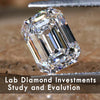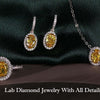
Tips For Buying a Lab Grown Diamond Engagement Ring in 2023
Although lab grown diamonds have been around for some time, recent media coverage has significantly increased their visibility. Despite their growing popularity, there are key factors to consider when choosing a ring for a lab grown diamond. It's essential to seek accurate information, as some traditional jewelers continue to spread misconceptions to protect their sales of earth-mined diamonds. If you're considering a lab grown diamond engagement ring, here are a few important points to keep in mind:
- Trusted reseller- Because there are so many vendors out there due to the popularity of lab grown diamonds, it's crucial to conduct your research and select a trustworthy supplier. Find vendors who are open and honest about their sourcing and manufacturing procedures and who provide certifications and warranties for their lab grown diamonds.
- Establish a budget- The cost of lab grown diamonds is frequently lower than that of their natural counterparts, however costs can still differ depending on the size, color, and clarity. Set a budget in advance to help you focus your search and find the perfect ring for you.
- Think about the 4 Cs- lab grown diamonds are rated using the same criteria as real diamonds: carat weight, color, clarity, and cut. Choose a diamond that fits your preferences and price range by deciding which of these elements is most essential to you.
- Choose the setting for your engagement ring- After selecting your diamond, think about the setting for your engagement ring. You have a range of metals and styles to select from, so consider what will go best with your diamond and sense of fashion.
- Get a certificate- For your lab grown diamond, be sure to obtain a certification that details the stone's dimensions, hue, clarity, and cut. This will demonstrate both the worth and genuineness of the diamond.
You may select a stunning and premium lab grown diamond engagement ring that matches your preferences and budget by keeping these points in mind.
How can you tell whether the lab grown diamond rings you're buying is Genuine one made in a lab?
It's important to obtain a grading report for your lab grown diamond rings from a reputable lab, such as IGI, EGL, or GIA. Lab created diamonds can cost up to 40% less than their earth-mined counterparts.
While earth-mined diamonds, particularly those of exceptional quality, can hold significant value, lab grown diamond engagement rings offer the same characteristics at a much lower price. If you find a ring priced in the hundreds rather than thousands, it may not be a true lab grown diamond.
Here are the following tips for purchasing a lab grown diamond engagement ring in 2023:
Tip 1 - Research Your Lab Grown Diamond Ring
Do some research to be sure the item you are purchasing is a lab created diamond ring. As most lab grown diamond rings may be bought online, you'll want to make sure the company is reputable.
When companies sell fake diamonds while giving incorrect information about them or even referring to them as lab created diamonds, it can be highly baffling.
Lab grown diamonds, which are real diamonds that are created in contemporary laboratory conditions that resemble the earth's natural growing conditions, are also known as synthetic diamonds, man-made diamonds, and engineered diamonds.
Tip 2 - Size & Shape Availability
Unlike in the past, lab created diamonds today come in a wide range of shapes and sizes. However, some shapes and sizes could be more difficult to locate. Discover your partner's preferences before perusing the assortment of lab created diamond rings.
The size and form of the diamond may have an impact on the ring style you choose. You might need to get creative and select a different cut set in a halo with a form that provides the desired effect if she has said that she would prefer a larger stone with a particular cut that is difficult to find in a lab diamond engagement rings.
Tip 3 - Choosing lab grown diamond Engagement Ring Style
It's critical to learn your partner's preferred style. To find out what she likes and doesn't like, check out her jewelry collection, consult your friends and relatives, or perhaps even snoop on her Pinterest profile.
Furthermore, take into account how various ring designs complement various diamond shapes. If all else fails, a traditional solitaire design is a safe bet.
Bonus Tip: Check the return policy before making an online purchase of a lab diamond engagement rings or lab created diamond in case you need to swap it for a different model or have the sizing done after the proposal.
Tip 4 - Consider a colored stone
Due to the availability of rare colored lab grown diamonds in shades like yellow, blue, and pink, you now have more options than just white. When compared to their earth-mined counterparts, fancy color lab grown diamonds are available for a significant discount, even more so than colorless lab grown diamonds.
- Yellow Fancy - 75% less
- Blue Fancy - 90% less
- 80% fewer Fancy Pink items
Extra Suggestion: If your soon-to-be bride prefers sapphires or rubies, think about lab created gemstones. Just with lab grown diamonds, you can obtain all the beauty without the conflict for a much lower price.
Tip 5- Learn the 4 C's
The 4 Cs - color, cut, clarity, and carat weight are crucial when purchasing a diamond, whether it was made in a lab or was mined from the soil. The 4 C's will help you determine the diamond's quality and have a big impact on its price.
The 4 Cs are significant, yet each grade is distinct for each diamond since each diamond is individual. If cost is a factor, pick a lower clarity grade because the majority of inclusions are imperceptible to the human eye.
Tip 6 - Work Within Your Budget
As lab created diamonds are less expensive, you get more for your money! Due to the savings, you may want to surprise her by enhancing the diamond’s color, clarity, cut, or carat.
Alternatively, you might consider custom-building her ideal engagement ring. Believe it or not, this option is more affordable than you might expect. You can purchase a stone of slightly inferior grade and greater size if the size is more essential.
Tip 7 - Don't Forget the Grading
If a lab created diamond does not have a verified grading report from a respected lab, such as the EGL USA, IGI, or GIA, do not buy it. Without a grading report, you might not have bought a lab created diamond. The industry requires full disclosure.
The five categories of the GIA color grading system are Colorless, Near Colorless, Faint, Very Light, and Light. Grades D, E, and F are included in the Colorless category. Even under a microscope, stones with the highest grade, D, are entirely colorless.
Before purchasing, lab grown diamond one must consider these grades and certifications for such from their respective sellers.
Tip 8 - Make it Special
If designing a personalized design is out of your price range, you can still make a "one-of-a-kind" ring by asking for a custom modification.
You may consider adding diamonds to the band, or, depending on the design, incorporating a hidden gem such as your birthstone into the band or gallery.
Feel free to ask your jeweler if it's possible to modify the shape of the center stone or change the prong style. Don't hesitate to share your vision with your jeweler they're eager to help you create or find the perfect piece.
Looking for something straightforward yet special? Engraving is the ideal method to give your lab created diamond engagement ring that little something.
Tip 9 - Working with a Limited Budget A Diamond Hybrid Simulant is an option.
Even if lab created diamonds are less expensive than earth-mined diamonds of the same quality, it's acceptable if they are still out of your price range. There are alternatives to lab created diamonds for prospective brides and grooms who are concerned about their budgets. Eco-friendly replacements, like the Diamond Hybrid®, can be found for a significantly lesser price and are just as gorgeous as their lab created counterparts.
Tip 10 - Give Yourself Time
It can take some time to select an engagement ring. Don't hurry the procedure. As she will be wearing it for the rest of her life, it is crucial that you select something that is the ideal combination of price, style, quality, and, most importantly, something she Adores!
How lab created diamonds might surpass mined diamonds?
Price
A lab grown diamond costs less than one that is mined. How much so will depend on the size range you have in mind. But, when comparing stones of similar grades, you may anticipate a price decrease of at least 30%.
Cut
The cut is one of the most important factors in determining a diamond's value and aesthetic appeal. Compared to mined diamonds, lab created diamonds typically have better cuts.
Size
If you purchase a lab created diamond rather than a mined diamond, you can receive a better and larger diamond at any given price point. Consider a 1.45 carat mined diamond with the characteristics G, VS1, and hue. You could purchase a 2-carat lab grown diamond with the same color and clarity for the same price!
Conclusion
Lab grown diamonds are an excellent choice for people looking for stunning jewelry without the stunning price tag because they are far less expensive than their mined counterparts. However, traditionalists who love natural jewels and have less financial worry may still find mined diamonds appealing.
In addition to this, it is known that these Lab diamonds are produced using two processes: HPHT and CVD (chemical vapor deposition) (high-pressure high temperature). Genuine, high-quality diamonds that are precise duplicates of those found in nature can be created using either method.
When buying a diamond, consider the four cs: carat, cut, clarity, and color. They affect how each diamond appears and are crucial considerations to keep in mind when looking for the ideal lab grown stone.
Leave a comment
Please note, comments must be approved before they are published.






























